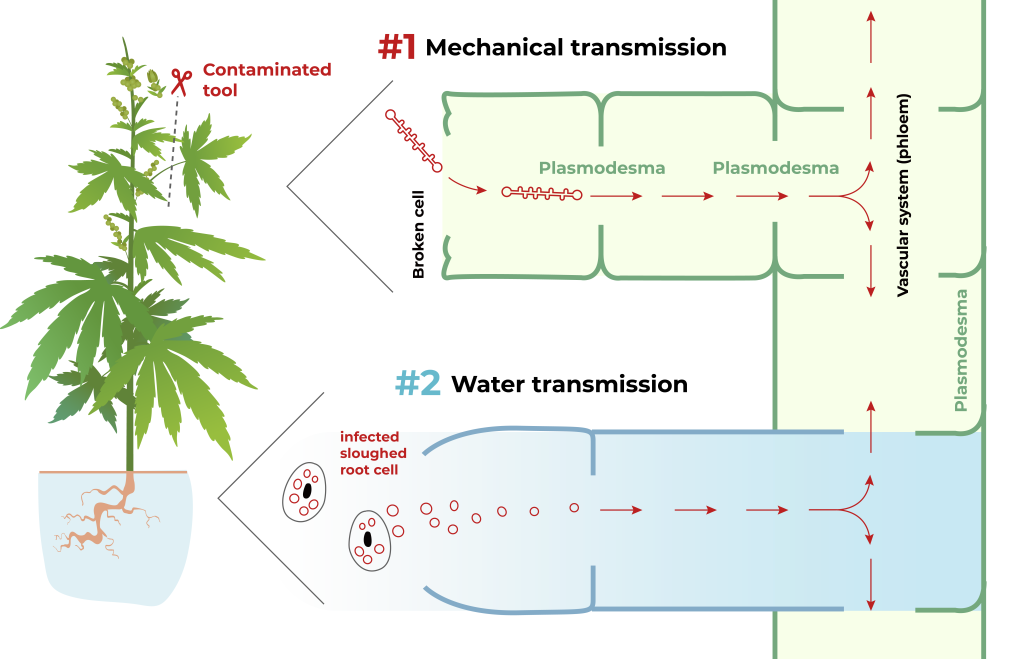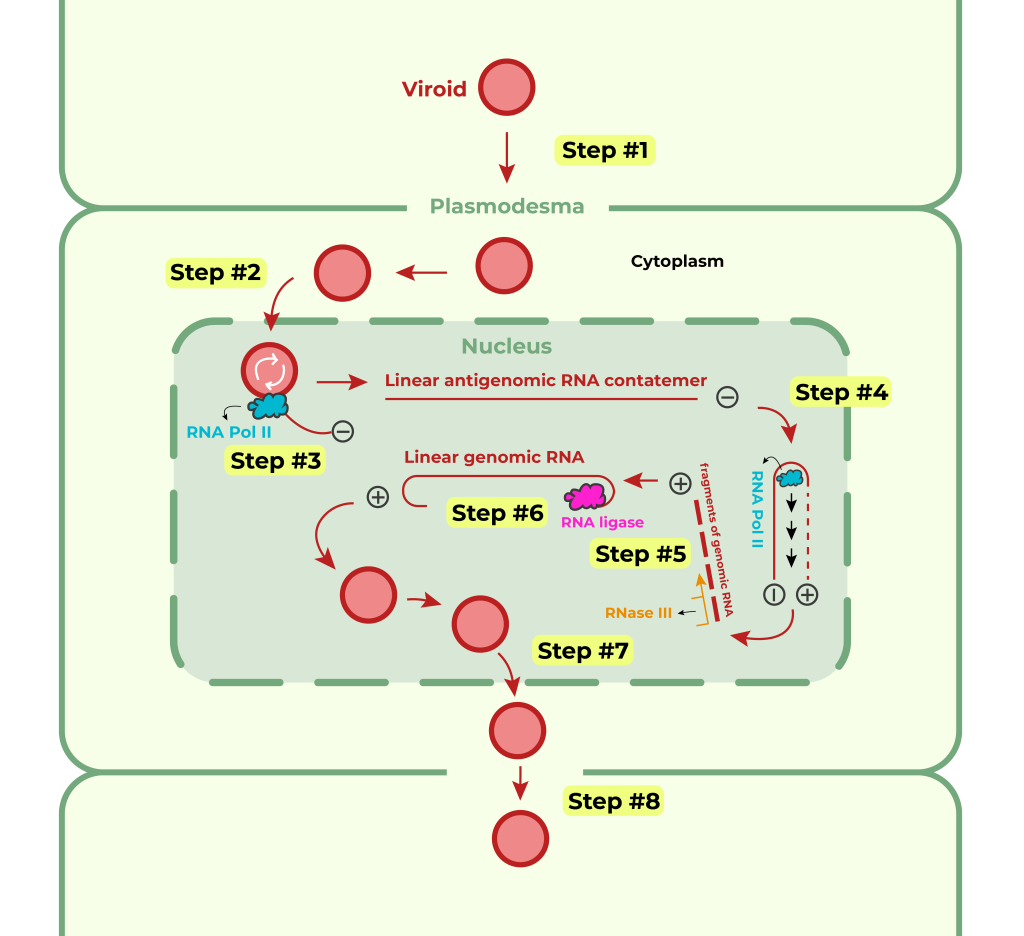
Hop Latent Viroid (HLVd): From Our Lab to You
In the years since its initial identification in Cannabis plants in Santa Barbara, CA (Bektaş et al., 2019), Hop Latent Viroid (HLVd) has been detected in cultivation sites across the state, presenting growers with a new set of challenges that threaten the health and productivity of their crop. In this article, we will take a quick look at HLVd, how it spreads, touch briefly on how the viroid operates within Cannabis plants, and then cover defensive strategies that growers can implement.
Viroids, a group of minuscule pathogens, boast an impressive smallness, typically measuring around 40 nanometers (nm). This diminutive size is attributed to their simplicity—a viroid consists of a short, single strand of circular RNA, lacking the protective protein coat (capsid) commonly found in viruses. Because of their size, viroids have the power to easily infiltrate our plants’ systems and induce severe diseases, such as HLVd, making them a substantial concern in agriculture and, more notably, in the realm of cannabis cultivation. The stealthy nature of their compact structure allows viroids to evade numerous defense mechanisms employed by their host organisms, resulting in rapid multiplication and wide dissemination.
But, how is HLVd spread?
- Vegetative propagation → Cuttings from infected mother plants are likely to harbor the viroid. Viroid particles present in clones will proliferate and progressively hamper clone growth throughout its entire life.
- Mechanical transmission → Cultural practices involving the use of contaminated tools and physical contact between infected and non-infected plants in close proximity are likely to contribute to viroid transmission. For example, a cultivator may prune an infected plant and then fail to properly sterilize their shears before pruning an uninfected plant; or even a cultivator may walk briskly through a densely packed grow, brushing up against infected and uninfected plants in quick succession.
- Water transmission → Growing conditions wherein water passes directly from infected plant roots to neighboring plant roots may play a role in HLVd transmission.
- Seed transmission → Seeds produced by infected plants may harbor viroid particles, which can then proliferate upon germination of the seed and during the growth of the plant.
- Vector transmission → Phloem-feeding pests have demonstrated the ability to transmit viroids from plant to plant, underlining the importance of implementing integrated pest management practices.

So, how does HLVd actually affect Cannabis plants? When this viroid enters the cells of a host plant, like Cannabis, it replicates by taking over the plant’s own genetic machinery (Wang, 2021). This leads to a disruption in the normal functioning of the plant’s genes (Štajner et al., 2019; Gómez, 2022). Depending on the plant’s age and when the viroid infects it, this disruption can cause a range of troubling symptoms, ultimately resulting in a lower yield and poorer quality of the harvested crop (Warren et al., 2019; Fernandez et al., 2023).
As time goes on, the viroid multiplies and moves from the point of entry in the infected plant to other parts through the plant’s vascular system (Fernandez et al., 2023). If not controlled, it can also spread to other plants within the cultivation facilities.
In the early stages of infection, it’s challenging to detect symptoms because the viroid levels are low, hence the “Latent” part of the viroid’s name. However, as the amount of viroid increases, more and more of each plant gets infected, and a larger proportion of the plant population becomes infected, leading to a greater impact on the grower’s crop.

What can be done to combat HLVd?
There are many ways for cultivators to mitigate the risks associated with HLVd. From our lab to you, here is what we suggest:
- Test your mother plants before propagation: Ensure you’re not producing clones from an infected mother plant. Consider sending tissue samples for viroid detection or set up your own viroid detection assays in-house.
- Test plants regularly throughout their lifecycle: Screen your plants at various points in their life to identify problems early. Infected plants should be removed, quarantined, monitored, or destroyed to prevent further spread.
- Properly sterilize all tools and equipment: Use a dilute bleach solution (3 parts bleach to 7 parts water) to sterilize tools and surfaces that come into contact with plant tissue. Sterilize equipment every time it’s used to prevent viroid transmission.
- Wear a fresh set of gloves: Use disposable nitrile or latex gloves and change them between handling different plants. Disinfect gloves with the bleach solution for added protection.
Although the threat of HLVd continues to loom over the Cannabis industry, the properly educated cultivator has little to fear. With the right skills, mindset, and tools, the challenges this pathogen poses—like any other—can be effectively mitigated through prevention, verification, and swift action.
References
Bektaş, A., et al. (2019) “Occurrence of Hop Latent Viroid in Cannabis Sativa with Symptoms of Cannabis Stunting Disease in California.” Plant Disease, 103(10), p. 2699. https://doi.org/10.1094/pdis-03-19-0459-pdn.
Fernandez i Marti, Angel, et al. (2023) “A Novel, Precise and High-Throughput Technology for Viroid Detection in Cannabis (MFDetectTM).” Viruses, 15(7), p. 1487. www.mdpi.com/1999-4915/15/7/1487#B9-viruses-15-01487, https://doi.org/10.3390/v15071487.
Gómez, Gustavo, et al. (2022)“Plant Epigenome Alterations: An Emergent Player in Viroid-Host Interactions.” Virus Research, 318, p. 198844. www.sciencedirect.com/science/article/pii/S0168170222001721, https://doi.org/10.1016/j.virusres.2022.198844.
Nataša Štajner, et al. (2019) “Evaluation of Disease Severity and Global Transcriptome Response Induced by Citrus Bark Cracking Viroid, Hop Latent Viroid, and Their Co-Infection in Hop (Humulus Lupulus L.).” International Journal of Molecular Sciences, 20(13), pp. 3154–3154. https://doi.org/10.3390/ijms20133154.
Wang, Ying. (2021) “Current View and Perspectives in Viroid Replication.” Current Opinion in Virology, 47, pp. 32–37. pubmed.ncbi.nlm.nih.gov/33460914/, https://doi.org/10.1016/j.coviro.2020.12.004.
Warren, J. G., et al. (2019) “Occurrence of Hop Latent Viroid Causing Disease in Cannabis Sativa in California.” Plant Disease, 103(10), pp. 2699–2699. https://doi.org/10.1094/pdis-03-19-0530-pdn.




